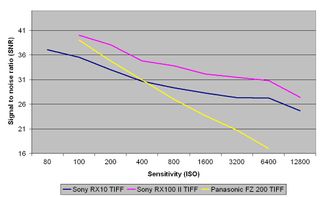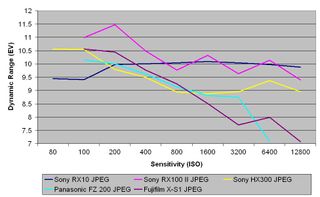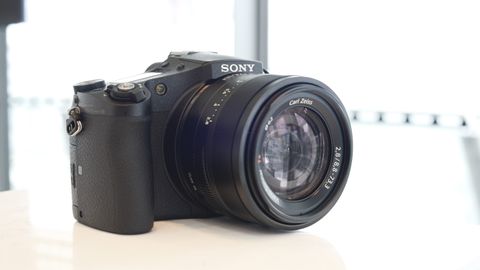Why you can trust TechRadar
We shoot a specially designed chart in carefully controlled conditions and the resulting images are analysed using DXO Analyzer software to generate the data to produce the graphs below.
A high signal-to-noise ratio (SNR) indicates a cleaner and better quality image.
For more more details on how to interpret our test data, check out our full explanation of our noise and dynamic range tests.
We have compared the RX10 with the RX100 II, with which it shares the same sensor, as well as some other traditional bridge cameras currently available on the market - the Sony HX300, the Panasonic FX200 and the Fujifilm X-S1.
JPEG Signal to noise ratio

Here we can see that the RX10 clearly beats the other cameras on test, with the exception being the RX100 II with which, as we would expect, it is very closely matched. At the very top end of the sensitivity run, the Sony HX300 just pips it, but it sits comfortably above the Fuji and the Panasonic throughout the sensitivity run.
Raw (after conversion to TIFF) signal to noise ratio

It's a little harder to compare raw format files, since so few bridge cameras offer this facility. However, we can that again it is reasonably closely matched with the RX100 II and shows a consistent performance across the range. The Panasonic FZ200 beats it at the lower end of its sensitivity scale (ISO 200), but the Sony overtakes it from the mid-range of ISO 400 and above.
JPEG dynamic range

The RX10 puts in a consistent performance across the sensitivity range, producing an almost flat graph. It is beaten at the very lower end of the sensitivity range (ISO 50-100) by the Panasonic FZ200, Fujifilm X-S1 and Sony HX300, but from ISO 200-400 upwards it either matches or beats the other cameras on test. The RX100 II, with which it shares the same sensor puts in similar scores, if a less consistent overall performance.
Raw (after conversion to TIFF) dynamic range

As we might expect, the RX10 puts in a reasonably similar performance to the RX100 II for raw format files (after conversion to TIFF) here. It beats the Panasonic FZ200 at every sensitivity too.
Current page: Noise and dynamic range
Prev Page Image quality and resolution Next Page Sample ImagesAmy has been writing about cameras, photography and associated tech since 2009. Amy was once part of the photography testing team for Future Publishing working across TechRadar, Digital Camera, PhotoPlus, N Photo and Photography Week. For her photography, she has won awards and has been exhibited. She often partakes in unusual projects - including one intense year where she used a different camera every single day. Amy is currently the Features Editor at Amateur Photographer magazine, and in her increasingly little spare time works across a number of high-profile publications including Wired, Stuff, Digital Camera World, Expert Reviews, and just a little off-tangent, PetsRadar.

An incredible $100 billion bet to get rid of Nvidia dependence — tech experts reckon Microsoft will build a million-server strong data center that will primarily use critical inhouse components

The real total eclipse was better than the pics I shot with my iPhone 15 Pro Max and DSLR, and believe me I tried

Quordle today – hints and answers for Sunday, April 14 (game #811)

